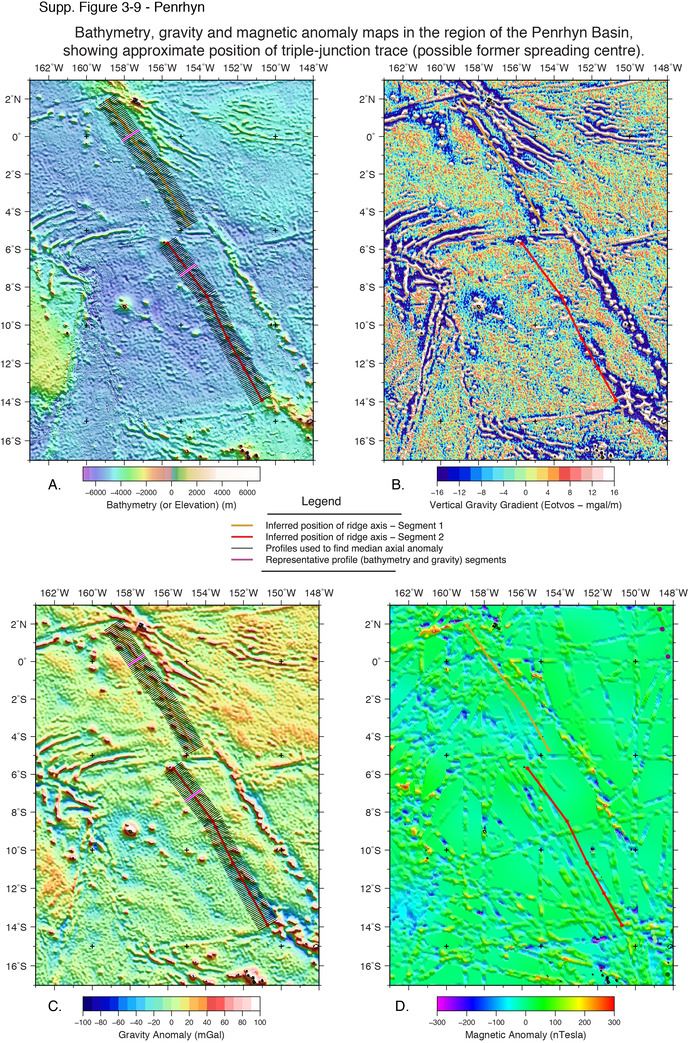| Ocean: | Pacific |
| Spreading centre type: | Large-scale extinct mid-ocean ridge |
| Time of cessation: | Prior to 105 Ma, during the Cretaceous Normal Superchron (Larson et al., 2002) |
| Subsequent active spreading centre: | Pacific-Bellinghausen spreading centre |
| Cessation style: | Not constrained by available data |
| Later deformation or volcanism: | Not known |
The Penrhyn Basin is found in the central western Pacific, East of the Manihiki large-igneous province. A possible extinct spreading in the basin is proposed to have formed either between Pacific and Phoenix plates (PAC-PHO) (Worthington et al., 2006), or the Pacific and Farallon plates (Viso et al., 2005), with uncertainty regarding the geometry of a probable triple junction plate boundary between the Farallon-Pacific-Phoenix plates (FAR-PAC-PHO) in this region. Resolving the location of the paleo-spreading centres has proven very difficult due to Cretaceous Quiet Zone (CTQZ) formed crust and other extinct ridges in the region that have been suggested as possible limbs of the complex spreading system include the Tongareva, Manihiki and Ontong Java systems.
The Penrhyn Basin is believed by some (Worthington et al., 2006) to be an eastern extension of the north-south spreading Osbourn Trough and may have marked the PAC-PHO plate boundary during the Cretaceous. Alternatively, Viso et al. (2005) believe the structure represents an east-west opening spread centre formed between the PAC-FAR plates. Viso et al. (2005) accepted the spreading-centre location of Larson et al., (2002), who term this structure the “triple junction trace”. Larson et al. (2002) interpreted this trace on the basis of the seafloor roughness and the trends of abyssal hill ridges, that they argue is related to the former plate boundary. However, the triple junction trace is not synonymous with the former axis of spreading, because it remains the trace of the ridge-ridge-fault placement and the spreading centre may have evolved rapidly during this development.
Sutherland and Hollis (2001) suggested that an additional plate boundary was active and that a short lived “Moa Plate” was present to the north of the Wishbone Scarp, to explain sampled data retrieved by ocean drilling at site DSDP 595/6. Sutherland and Hollis (2001) proposed that basalts from this location yield a paleolatitude of 63° S, further south than similar age Pacific plate crust. The Moa Plate is proposed to have formed a N-S spreading centre with both the Phoenix and Farallon Plates during the Lower Cretaceous (137 Ma) (Sutherland and Hollis, 2001). They also require a dextral strike-slip margin from some time after 137 Ma, in order for the sampling location to be consistent with Australian paleomagnetic data.
Not directly discussed, however likely to have been result of plate-boundary reorganizations at the triple junction.
Due to the considerable uncertainty regarding the location of the extinct spreading centre in this region and the lack of a recognisable linear surface gravity or bathymetric feature we did not include the Penrhyn Basin in the statistical anaylsis undertaken.
Larson, R.L., Pockalny, R., Viso, R., Erba, E., Abrams, L. J., Luyendyk, B. P., Stock, J. M., and Clayton, R. W., 2002, Mid-Cretaceous tectonic evolution of the Tongareva triple junction in the southwestern Pacific Basin, Geology, v. 30, no. 1, p. 67–70.
Sutherland, R. and Hollis, C., 2001, Cretaceous demise of the Moa plate and strike-slip motion at the Gondwana margin, Geology, v. 29, no. 3, p. 279–282.
Viso, R. F., Larson, R. L., and Pockalny, R. A., 2005, Tectonic evolution of the Pacific-Phoenix-Farallon triple junction in the South Pacific Ocean, Earth and Planetary Science Letters, v. 233, p. 179-194.
Worthington, T.J. et al., 2006, Osbourn Trough: Structure, geochemistry and implications of a mid-Cretaceous paleospreading ridge in the South Pacific. Earth and Planetary Science Letters, v. 245, no. 3-4, p. 685–701.


